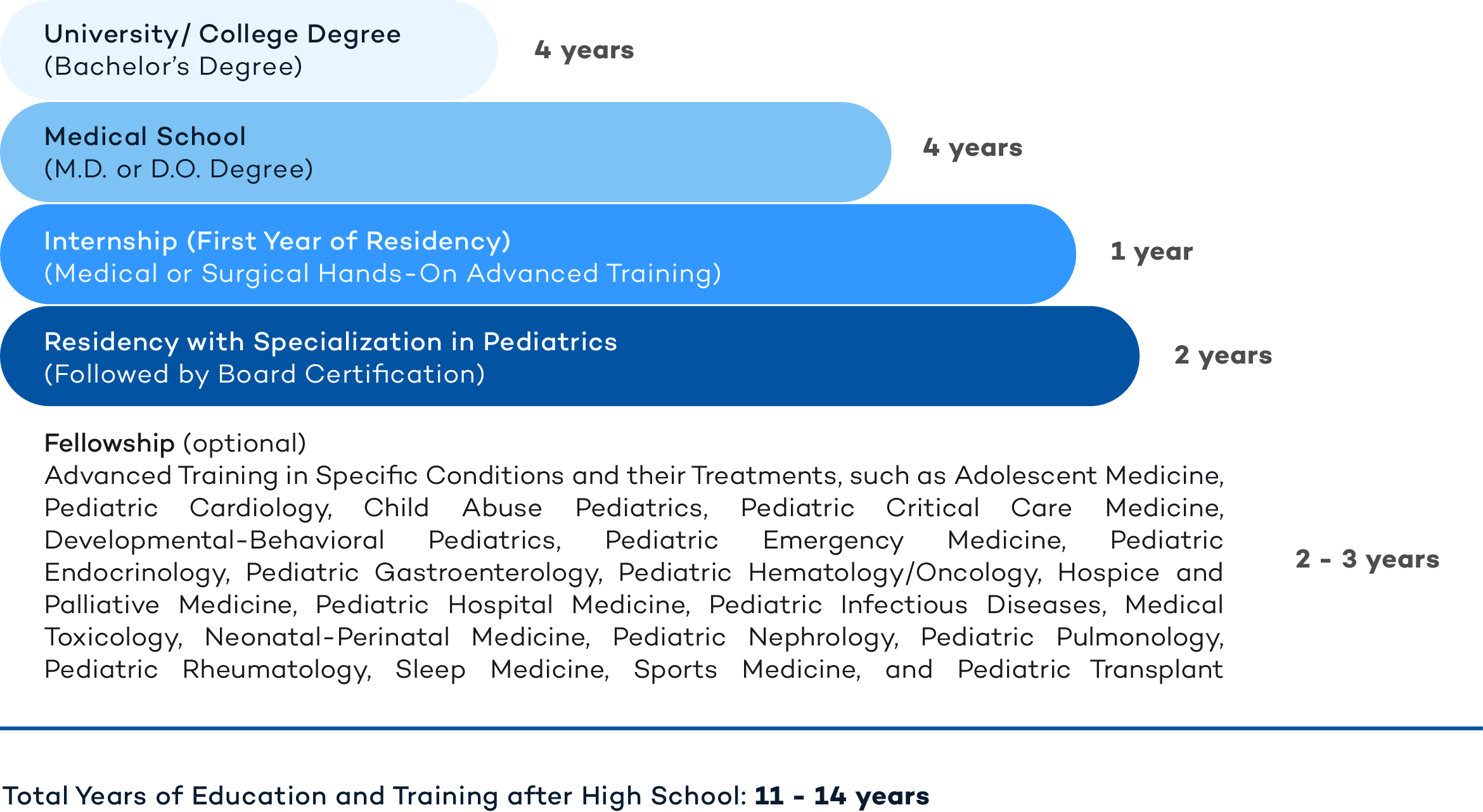

A Pediatrician is a Board-Certified Doctor who focuses on the physical, emotional, and social health of infants, children, adolescents, and young adults from birth to 21 years of age. Pediatric care is comprised of an extensive range of health services ranging from preventive health care to the diagnosis and treatment of acute and chronic diseases.
Pediatric physicians have specialized expertise in the management of physical, behavioral, developmental, and social problems that affect children and young adults. They diagnose and treat infections, injuries, and many types of organic diseases and dysfunctions, aiming to reduce mortality, foster healthy lifestyles, and ease chronic conditions of infants and children.
When searching for a pediatrician, you may review and check his/her credentials, practice style, and expertise, including clinical reviews, with the help of your family and friends. At myDoqter, you have access to patient feedback about doctors, and you can also see the professional recommendations given by other physicians who have witnessed first-hand the expertise and professional competency of your doctor.
The following is representative of the years of educations and training that a pediatrician has undergone.

PED from the Greek root ‘Pais’ which means ‘Child’ + DIACTICS from the Greek word ‘iatros’ which means ‘doctor or healer’.
Pediatricians treat an extensive number of conditions in children and adolescents, including:
Allergies: Abnormal immune system reactions to foreign substances that commonly produce symptoms such as itchy eyes, runny nose, and skin rashes. Anaphylaxis is a severe and potentially deadly form of allergic reaction. The most common cases are associated with foods, insect stings, medications, and latex.
Anemia: A condition in which there are low numbers of red blood cells that can result in less than optimal oxygenation of the body’s tissues. This can commonly cause a variety of symptoms including fatigue and hair thinning.
Anxiety Disorder: Consists of a number of conditions including generalized anxiety disorder, panic attacks, agoraphobia, social anxiety disorder, separation anxiety, and phobias. Anxiety disorders are not uncommon in children and produce excessive fear or worry.
Appendicitis: A condition in which there is inflammation of the appendix (a portion of the intestines or bowels, which is located on the right lower abdomen). This may lead to swelling and sometimes infection. Children may experience sudden onset of abdominal pain, especially in the lower abdomen.
Asthma: A chronic long-term inflammatory disease of the lungs in which the airways of the lungs narrow, resulting in difficulty breathing and moving air in and out of the lungs. Fortunately, numerous effective treatments are available to treat asthma.
Autism Spectrum Disorders (ASD): ASD specifically encompasses complex challenges in social, communication and behavioral aspects of development, in various degrees. According to the CDC, the prevalence of ASD has consistently increased over the past two decades, with the most recent rate of diagnosis approaching approximately 1 in 54 children. Early intervention services have demonstrated to be beneficial for children with ASD to gain essential skills and lessen overall impairment. Without the specialized knowledge in human development and astute clinical capabilities of Pediatricians, many of these children would go undiagnosed completely, or until later in life, resulting in lost access to these early supports that can scaffold and foster young minds’ social and emotional well-being.
Bedwetting: Also called nocturnal urination, this condition is characterized by urinary incontinence during the night in children over the age of 5.
Cold, Influenza, and Viral infections: Children can become infected with a variety of respiratory viruses, from the common cold to the influenza. Other viral infections include gastroenteritis from rotavirus, a type of infection that causes severe diarrhea, most common in children under the age of 5. Vaccines are available to protect against a variety of common viral infections such as measles, mumps, hepatitis, and chickenpox.
Croup: This condition is most often caused by viruses that produce inflammation of the upper airways and vocal cords, resulting in a distinct barking cough and difficulty breathing.
Constipation and Diarrhea: These are common symptoms that affect the bowel movements of children. Both conditions can result in serious health consequences and should be evaluated by your pediatric physician.
Depression: A mood disorder that causes a constant sense of unhappiness. Children with depression may demonstrate a lack of interest in the activities that they typically enjoyed before, as well as and fatigue and lack of energy. It may also be accompanied by disruptions in eating, sleep, and even physical symptoms like stomach pain and headache.
Diabetes: This is an autoimmune condition that affects the pancreas in young children. This results in a chronic state where there is difficulty processing glucose (sugar) in the body, and can lead to dangerously low or high sugar levels in blood and long-term complications.
Diaper Rash: This is a common condition affecting newborns and toddlers, and it should be treated in order to avoid more extensive spread and possibly skin erosions and other complications. It occurs in the area of skin that is covered by diapers, where both sweat and urine can cause excess moisture, leading to irritation of the skin and the growth of a fungal organism called yeast. It shows as patches of irritated, bright red skin, sometimes with erosions and oozing. Your pediatrician will provide the appropriate treatment for this condition and help you avoid future flares.
Ear Infection: This condition is common in young children and consists of swelling, and often infection, of the ear. In particular, the middle section of the ear tends to be affected. Children with ear infections often complain of pain in this area, and very young children may communicate this by pulling at their ears.
Eating Disorders: They include conditions such as anorexia and bulimia, and are associated with irregular or disturbed eating habits. These conditions can have a profound impact on the proper growth and development of children.
Eczema: A skin condition where the skin becomes red, itchy, irritated, and inflamed. Eczema may occur more commonly in kids with asthma and allergies. In some cases, eczema flares may be due to allergic reactions to objects or substances touching the skin, such as shoes and certain fabrics (wools).
Febrile Seizures: These are convulsions that occur in children in the setting of high fevers, when there are spikes in body temperature above the body’s standard temperature of 98.6°F or 37°C.
Gastroenteritis: Consists of inflammation of the Gastrointestinal (GI) tract, and is often caused by intestinal infection from viruses, bacteria, or parasites. Fever and diarrhea are common symptoms in children with viral gastroenteritis.
Hand, Foot, and Mouth Disease: This is a rash that affects skin on the palms and soles, and the palate in the mouth. It is caused by a virus that produces blisters in the mouth and a rash on the hands and feet.
Head Lice: This is considered an infestation that occurs when parasites called “lice” infect the hair of children. The lice feed on human blood and can be found on the head, eyebrows, and eyelashes.
Learning Disabilities: These are conditions where there is delayed learning in children, and they can lead to additional consequences such as loss of self-confidence. Examples of learning disabilities include dyslexia and ADHD.
Pneumonia: This is a type of lung infection caused by bacteria, viruses, or fungi, leading to swelling of the air sacs in one or both lungs. The lungs’ reaction to the infection is accompanied by inflammation and swelling, which can fill the lungs with fluid or pus. This can impair breathing and affect the levels of oxygen in blood.
Sleep Apnea: A serious sleep disorder in which breathing is briefly, and repeatedly, interrupted during sleep. It can produce significant problems with the oxygenation of the blood (amount of oxygen carried in blood through the body to the various organs and the brain). As a result, sleep apnea can lead to poor sleep and excessive fatigue.
Urinary Tract Infections: These infections occur when any portion of the urinary tract, including the kidneys or bladder, become infected and produce associated symptoms of painful or burning urination, cloudy urine, and/or abdominal pain.
In addition to diagnosing and treating common childhood injuries and illnesses, Pediatricians are in a unique position to support and provide resources to nurture individual development for every child, which is especially critical for those with Autism Spectrum Disorder (ASD) as well as other neurodevelopmental conditions, like Attention Deficit Hyperactivity Disorder, intellectual disability and cerebral palsy.
Similarly, your General Pediatrician is a gateway to specialized care for myriad genetic and congenital diseases that require chronic management from birth onward. You may have heard some of these terms: cystic fibrosis, fragile X, congenital heart disease, congenital adrenal hyperplasia, muscular dystrophy, hemophilia and Down syndrome. There are numerous others, and Pediatricians who specialize for 3 years after completing residency are able to guide treatment and offer more specific support.
Prevention of diseases in children and young adults is extremely important and helps maintain overall health of the entire body as children develop. The American Academy of Pediatrics recommends individuals 21 and younger to be under proper pediatric care with a Board-Certified Pediatrician. Recommendations for Preventive Pediatric Health Care have been endorsed by the American Academy of Pediatrics though a Periodicity Schedule that addresses both normal development patterns as well as the unique considerations of each child. Important areas include:
Your family pediatrician will offer you and your children personalized choices and will work with you to find the best approach for your child’s healthcare needs. Make sure to discuss all these options and other preventive recommendations with your physician.
Content Contribution: Heather Machin, D.O. – Board Certified Pediatrician
https://pediatrics.aappublications.org/content/135/4/780
https://www.aap.org/en-us/professional-resources/Path-to-Pediatrics/Pages/fellowship-training.aspx
https://pediatrics.aappublications.org/content/145/3/e20200013
https://www.aap.org/en-us/professional-resources/Pediatrics-as-a-Profession/Documents/Peds101book.pdf
https://downloads.aap.org/AAP/PDF/periodicity_schedule.pdf